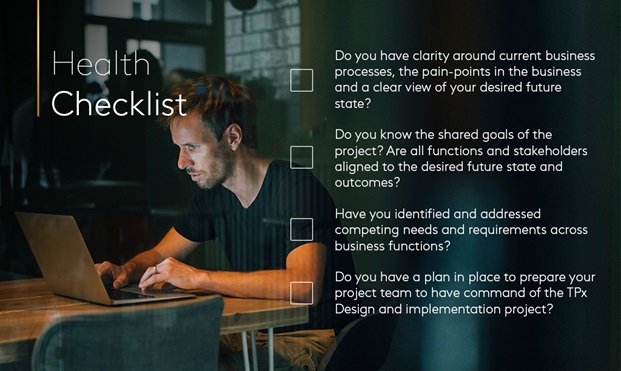Trade promotion digitisation projects are a top priority for consumer goods manufacturers looking for growth opportunities in a rapidly changing landscape. No matter where you are in your TPx journey, including best-in-class methodology into your approach is a must. One “must” is the TPx project starting point – the pre-design assessment phase. It prepares the project team and the business for a well-executed project and eliminates many of the common challenges that can undermine or derail the critical design phase. It saves time, keeps the project on track, and avoids unexpected surprises.
Think of the TPx project as a construction site. Pre-design assessment is like building the foundation upon which a great structure will emerge. Laying down a solid base by validating needs and requirements, uncovering potential gaps, and anticipating the potential impact a change will have on the project, is a time investment worth making. Many participants on TPx project teams will likely not have been through a TPx design and implementation process before. Pre-design assessment provides a unique opportunity to engage with project team members and help them build confidence and understanding of the task ahead, ensuring that when the main event starts, they are well prepared, know what to expect, and are ready to play the active role that the project demands of them.
“We decided to use pre-design assessment so we could slow things down to build momentum for us later,” said one leading CPG manufacturer. “Our primary goal was to understand our readiness, pain-points, protocols, and gain ideas to make early decisions and to reduce risk in the implementation early, which has shown to be a good decision.”

If you are starting a TPx project and answered “no” to any of the items on the checklist above, then consider hitting the pause button and take a deeper look at the following three key areas – processes, data, and people – before starting your TPx design and implementation.
Process: Setting the foundations and path to success
The pre-design assessment uncovers and addresses pain-points in current ways of working and the aspirations of the organisation for the desired future state within the context of the new TPx solution. Many businesses have evolved and established their current ways of working, seeking workarounds and offline solutions for the needs that they are not able address within the current toolset. Pre-design assessment creates the opportunity to explore and challenge the current paradigm and cast off the constraints of the “as-is” reality.
Master Data: The structural skeleton of the new solution
Assessing master Data is a pivotal area of focus during pre-design. It is the structure upon which the planning, transactional, and reporting processes will be built within TPx. Taking time up front to review and evaluate the master Data structures, quality, and accuracy will ensure that this does not become an unnecessary constraint to design. Getting this right can be complex and challenging and will typically require the involvement of multiple cross-functional stakeholders within the business, so this is an area worth getting started on early in your journey.
“Master Data can be a killer in an organisation. When we started, we addressed our customer master Data and not our product master Data, which was a mistake,” another leading CPG manufacturer told us. “When your system goes live, if you don’t also have the product data clean, inaccuracies will come up and people will blame the TPM solution, not the bad data. So, looking back, I would have spent more time building the data and making sure we had an accurate data assessment around granularity and quality. I’m glad to see Kantar is calling it out into their process.”
People: Embracing change
Pre-design assessment ensures that there is a clear understanding of the expertise and representation needed in the core and extended project teams. It brings in and aligns internal stakeholders from the beginning of the journey and provides early insights around the change that lies ahead. These stakeholders will become a tight-knit team and change ambassadors, driving engagement and buy-in by evangelising how the new solution creates value.
“We learned to have conversations with cross functional partners early and often. It will set you on a change management path,” said a leading CPG manufacturer.
Best practices
- Bring in stakeholders early and create a cross-functional core project team: Ensure a common understanding of current pain points, specific business needs and requirements, identify gaps, and set the grounds for change management.
- Set expectations early: Build a clear understanding of the project scope and the likely changes that will result to ensure a smoother transition to new ways of working.
- Avoid force fitting old processes into new solutions: Adopt a growth mindset, revisit and challenge current processes, cast off the constraints of current tools, and embrace better, more efficient ways of working.
- Revisit data sources and data structures: Make sure your master Data supports the way the business wants to work within the TPx solution to enable and support business goals and objectives.
Webinar: Pre-Design with Clif Bar
In a recent webinar, we sat down with Clif Bar to learn about their Pre-Design Assessment experience as the launch to their digital transformation journey. Watch the webinar to hear why the Pre-Design phase was valuable to establishing a trade promotion management foundation by filling out the form below.


